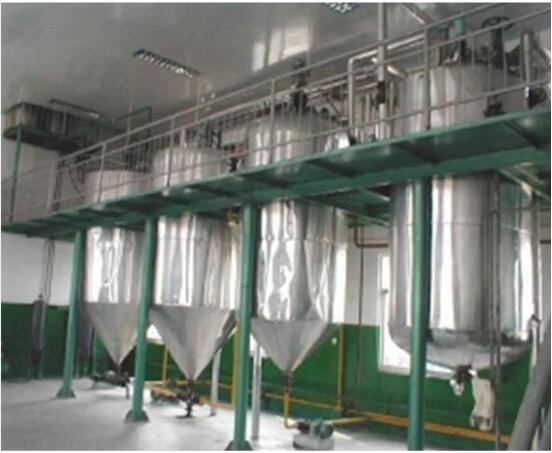The absorption rate of rapeseed oil is very high, up to 99%, and it has a certain effect of softening blood vessels and slowing down the aging process. Therefore, an increasing number of people are getting into the rapeseed oil refining business and processing cooking oil with rapeseed oil refineries not only satisfies the self-imposed demand for household cooking oil, but can also be a profitable business choice for investors.

Rapeseed Oil Refinery Plant Machinery Exported to Ethiopia
Recently, there was a 50TPD rapeseed oil line shipping to Ethiopia for the customer’s raw materials of rapeseed, peanut and cottonseed. In addition, the customer has its own 150 TPD oil extraction line for the production of rapeseed oil, peanut oil and cottonseed oil. According to the client, we know that due to increased human consumption and health consciousness, the demand for refined rapeseed oil in the Nigerian market is expected to show significant growth in the coming years. He is considering setting up a large commercial rapeseed oil refinery to obtain higher quality rapeseed oil to start his lucrative rapeseed oil refining business.

3 Steps to Make A Complete Rapeseed Oil Refinery Plant Business Plan
Before the customer is ready to design the rapeseed oil production line project for investment, we will provide some free design drawings and solutions based on the information and give some technical guidance.
Step1 Complete Rapeseed Oil Refinery Plant Plant design
Analysis Market and Selection Location:Do a market survey of local edible oil refineries. If you intend to invest in establishing your own edible oil refinery, you need to understand the uniqueness of your specific plan compared to existing players. Use your revenue projections to select the most attractive segments in the area by determining your basic achievable market share.
Step2 Familiarity with the processing of rapeseed oil refineries
Canola oil refining mainly includes the processes of hydration, alkali refining, decolourisation and deodorisation. Becoming familiar with the rapeseed oil production process is an important step in preparing to invest in an edible oil refinery.
Step3 Focus on the Factors affecting prices and costs
- Raw Material Cost:
It is important to plan to buy large quantities of vegetable, peanut and soybean based materials during the harvest season to get the best price. In your business plan, explain your sources of materials and potential suppliers after your market assessment.
- Rapeseed Oil Refinery Plant Machinery Cost:
A business plan for investing in rapeseed oil refining production will focus on plant and equipment, as the biggest outlay for the initial cost you will need to invest in high quality equipment to achieve high quality rapeseed oil. You can also invest in bespoke equipment to suit your needs, which will require more investment, using expert advice on the rapeseed oil refinery machinery you need before making a budget.

Pretreatment for Rape Seeds
This is the process where the seeds are prepared for extraction of oil; the process utilizes energy to rapture or make the walls of the seeds weak. This energy can be obtained through mechanical way by grinding, breaking, rolling, pelleting and pressing the seeds. You can also use thermal energy using hydraulic oil press to break the cells of the seeds. This rapeseed oil production equipment is used to produce energy that helps in reducing viscosity in the seeds and adjusting the content of moisture in the seeds.
Dehulling
This process serves the purpose of removing fiber and other pigments which can low the value of the final product. It involves dehulling, cooking, and separating the hulls. However, you are required to cook the rapeseed for up to 10 to 15 minutes. It is approximated that at this temperature the seeds will reach moisture content.
There are also scenarios that the temperatures can be raised up to 200 but the quality of oil and moisture content will not be affected. The disc mill is the equipment that performs all the process but you must have it regulated at all times. The disc spacing and rotation speed helps in drying the seeds but it can also be used with sulfur compound to achieve maximum results.
Rapeseed Oil Extraction
This process can be achieved through seed cleaning equipments that consist of screening to remove any oversized particles. Flaking includes rupturing the rapeseeds to allow oil to get in the flake and then they are cooked at 75 to 85 temperatures in the roasting equipment. Then they are passed through screw pressing, in which screw oil press equipment is used to press the small flakes into sizeable particles.
The seeds are then passed in the hexane for further extraction of oil, later they are taken to desolventizing to remove hexane and then they are further purified in the distillation and then finally in the degumming.
Oil Purification of Extracted Rapeseed Oil
The crude oil has to be refined to obtain high quality standards; the natural impurities like water, dirt, fatty acids, matter and color are removed through the following refining processes; drying, bleaching, neutralization, deodorization and degumming. Bleaching is used to remove color in the rapeseeds and in deodorization; the seeds are taken through vacuum tube equipment to remove traces that might bring bad odor to oil. The fatty acids in the oil are neutralized by alkali solutions. Finally the manufacture can add food addictives to make the oil more quality. The addictives are also used to maintain the quality of the oil when it is being transported.
